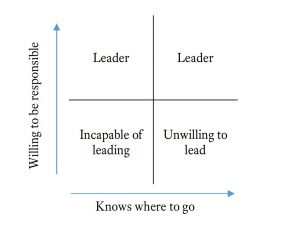I thought it would be helpful to include an illustration of what I mean by the two reasons we follow a leader.
As I tried to reduce leadership to its most basic elements, I was left with two principles: willingness to be responsible and knowing where to go. The relationship between the two feels straightforward, but it’s a little more complex than it immediately appears.
First off, to describe those who aren’t leaders. A person who doesn’t know where we’re going and isn’t interested in shouldering any responsibility for getting us there is simply incapable of being a leader.
Someone who knows where to go but isn’t interested in the responsibility is different. This person is capable of leading but refuses to do so. Those who distinguish between a “boss” and a “leader” are describing this sort of person.
The person who doesn’t know where to go but is willing to take the responsibility is really incapable in one sense. They’re incapable because at the beginning they don’t have the knowledge necessary to attain the objective. But their willingness enables them to figure out how to get to the destination and (maybe) gives them the determination to keep trying. This person isn’t guaranteed to get us to the goal but, at least for a while, they’ll help us move along the path.
The best leader is the one who knows how to achieve the goal and is willing to take responsibility for getting us there. Because they know how to get to the goal, they can direct us with confidence and a minimum of trouble. Because they’re willing to be responsible they understand that they’ve accomplished very little if they reach the destination alone. They understand that their role isn’t just to reach the goal, it’s to expand (and probably extend) the capacity of each follower so that we can reach the goal. No guarantees of success here either, but this is the closest we can get.
P.S – I know, there are other important dimensions to leadership. But simplifying to two classes is a helpful way to start thinking about it.
